|
The Ruger .44 magnum rifle is back!
Introduced a few years ago, the bolt action 77/44 rifle was a
handy little carbine, and has proven itself in the fields and
woods in the hands of deer hunters. It is especially popular
where the deer grow large and the hunting ranges are relatively
short, like in the Eastern and Midwestern United States. In
those areas, big-bodied deer prevail, hunters like
quick-handling carbines that hit hard, and the 77/44 fills the
bill perfectly. Anyway, after being dropped from the catalog for
a while, the trim little thumper is back in production, in an
All-Weather variation that should prove to be very popular with
hunters. The little 77/44 wears a black synthetic stock, and the
barrel, receiver, scope rings, and trigger guard are made of
stainless steel. While on the subject of scope rings, Ruger
includes them with their centerfire rifles to mate up perfectly
with their integral scope bases which are machined into the top
of the receiver. This is a very strong, solid scope mount
system, and including it with their rifles saves the owner at
least fifty bucks, and also saves the trouble of having to find
bases and rings to match the rifle. It is a great idea that I
would like to see other rifle makers adopt. The 77/44 wears a
very good set of open sights, but for me, my hunting rifles wear
scopes. I can place my hits more precisely with a scope, and
that makes me a better hunter. I use open sights on my hunting
revolvers, but keep the ranges close, as I know my limitations.
The black synthetic stock is relatively
lightweight compared to a dense wooden stock, and has checkered
panels on the pistol grip and forearm to assure a solid grip
under adverse weather conditions. The stainless steel wears a
satin finish that contrasts nicely with the black stock,
resulting in a really good-looking little carbine. Ruger lists
the weight of the 77/44 on their website at an even six pounds,
but mine weighs in at five pounds, seven ounces on my scale,
which is usually pretty darn accurate. With an eighteen and
one-half inch barrel, the overall length is only thirty-eight
and one-half inches. The length of pull measures thirteen and
seven-eighths inches, and the 77/44 balances perfectly and comes
to the shoulder like a svelte English bird gun. That makes all
the difference in the woods. Hunting dense woods and along the
edges of fields requires a gun that jumps to the shoulder almost
instantly. A heavy rifle is slow into action, and while such a
rifle might be just fine while hunting from a stand which
overlooks a long field or power line, a light, quick-handling
carbine with plenty of power is best in the thicker stuff, and
that is where a carbine like the 77/44 is greatly superior to a
longer, heavier, ill-balanced rifle.
I have to admit that I have never paid much
attention to the Ruger .44 Magnum rifles before. Ruger has had
handy little .44 magnum carbines in production almost steadily
for over four decades now, and I have never spent much time
behind one, or given much thought to the concept, usually
focusing upon lever actions, full-sized bolt guns, and single
shots. However, a handy bolt action such as this 77/44 has a lot
of merit, and as soon as I picked it up, I was sold on the
concept, with the reservation that I would have to see how well
it shoots first. I love rifles, but if they are inaccurate, I
have no use for them.
The .44 Magnum has proven itself plenty
capable of taking medium and large game for over fifty years
now, when fired from a good handgun. From an eighteen inch rifle
barrel, the .44 magnum is even more of a good thing. Compared to
a standard revolver, you will gain between 300 to 400
feet-per-second (fps) firing the same full-power .44 Magnum load
from the rifle barrel, due to its closed breech and longer tube.
I tried several different factory loads and hand loads from the
77/44 rifle’s barrel to check for velocity, and every load
posted a significant gain over what I usually get from the same
ammo when fired from a sixgun. The Ruger’s magazine
limits cartridge overall length, just as a revolver’s cylinder
does, but I was still able to load bullets as heavy as 320
grains, crimped into the crimp groove, and still fit inside the
magazine. Keith style bullets, with their long noses, usually
will not work in the 77/44 magazine when loaded into magnum
cases, but LBT style cast bullets fit well, feed well, and hit
hard. For heavy, tough game like large hogs, I like a heavy cast
lead bullet. For lighter game like Southern whitetails, I prefer
a good hollow point, and there are many good ones on the market.
Chronograph results are listed in the chart below, with velocity
readings taken at a distance of twelve feet from the muzzle.
Velocities are listed in feet-per-second (fps). Bullet weights
are listed in grains. Powder weights are also listed in grains.
Velocity readings were taken on a calm, muggy day with an air
temperature in the eighty-five degree Fahrenheit range and a
relative humidity of eighty-two percent, at an elevation of
approximately five hundred feet above sea level. JHP is a
jacketed hollow point bullet. JSP is a jacketed soft point
bullet. WFN is an LBT-style hard-cast lead bullet with a wide,
flat meplat. LFN is a truncated cone flat point cast lead
bullet.
Factory Loads
|
Ammunition |
Bullet Weight |
Velocity |
| Cor-Bon JHP |
165 |
1710 |
| Cor-Bon JHP |
240 |
1862 |
| Cor-Bon JHP |
260 |
1693 |
| UMC JHP |
180 |
2151 |
Handloads
| Bullet |
Bullet Weight |
Powder / Charge |
Velocity |
| Cast Performance WFN |
320 |
20 grains H-110 |
1503 |
| Cast Performance WFN |
300 |
20 grains H-110 |
1488 |
| Tennessee Valley LFP |
300 |
20 grains H-110 |
1530 |
| Cast Performance WFN |
300 |
22 grains H-110 |
1625 |
| Cast Performance WFN |
320 |
22 grains H-110 |
1599 |
| Tennessee Valley LFN |
300 |
22 grains H-110 |
1677 |
| Hornady JHP |
250 |
22 grains H-110 |
1605 |
| Cast Performance WFN |
320 |
8 grains Trail
Boss |
890 |
| Tennessee Valley LFN |
200 |
12.1 grains AA-5 |
1463 |
From the numbers listed above, it is obvious
that this Ruger 77/44 carbine packs a considerable punch.
However, recoil is not punishing at all. The stock is very
well-designed and comfortable. All Handloads functioned
perfectly, feeding well and exhibiting no signs of excessive
pressure. The 260 grain Cor-Bon load seemed a bit on the warm
side for this particular rifle, with a very flattened primer,
and sticky extraction. For a mild-recoiling load that still has
plenty of punch for lighter game, without destroying any meat,
that 320 grain Trail Boss load is a dandy, exhibiting very good
accuracy, relatively low noise, and mild recoil.
For accuracy testing, I gathered together
several .44 Magnum loads, both factory stuff and my handloads,
firing for groups at ranges of fifty and one hundred yards.
The 77/44 carbine exhibited very good accuracy from the bench,
despite a heavy but crisp trigger pull that measured five and
three-quarters pounds. This trigger pull is fine for the woods,
but from the bench, I do much better with a much lighter pull.
However, putting a target grade two pound pull on a rifle meant
for hunting the thick brush would not be a good idea, and the
trigger pull as is would serve just fine. Groups at fifty yards
measured from just over half an inch to one and one-quarter
inches, depending upon the load chosen. At one hundred yards,
the smallest groups measured one and one-quarter inches, with
some loads opening up to just over two and one-half inches. All
of the jacketed bullet loads performed very well, grouping under
one and one-half inches, which is very good accuracy, and leaves
the hunter no excuse if he misses his game out to at least one
hundred and fifty yards.
I mounted a dandy little 1.25 to 4 power
Trijicon AccuPoint scope atop this 77/44 carbine. The
AccuPoint has a post reticle with an illuminated point at the
top. The brightness of the red point is adjustable with a
sliding cover atop the fiber optic illuminator, allowing the
intensity of the glowing red point to be adjusted to suit the
lighting conditions. In total darkness, the red point is
illuminated by Tritium. The unit is always “ON”, and never
needs batteries. At the lowest power setting, it is very
fast; quicker than any open or aperture sight, and the shooter
can leave both eyes open. Adjusting the power up gives
greater magnification for longer shots. It is the perfect scope
for a rifle of this type, and its trim dimensions fit well on
the 77/44 rifle.
The Ruger 77/44 is a fine little carbine.
Light, handy, and powerful enough for any game in North America.
With five shots of.44 magnum power, and keep in mind that this
carbine is much more powerful than a .44 Magnum revolver, it can
handle most any hunting need imaginable at short to medium
ranges. The 77/44 is built to resist all kinds of foul weather,
built to last, and built in the USA.
Check out the full line of Ruger products
here.
Also, for a limited time, Ruger is throwing
in a very good Carhartt jacket with the purchase of any Ruger
bolt action rifle, to sweeten the deal just a bit more. You can
also get info on that at Ruger’s website.
For a closer look at the Trijicon premium
optics, go to www.trijicon.com.
To find a Ruger dealer near you, click on the
DEALER LOCATOR at www.lipseys.com.
To order the 77/44 online, go to www.galleryofguns.com.
Jeff
Quinn
NOTE: All load data posted on this
web site are for educational purposes only. Neither the author nor
GunBlast.com assume any responsibility for the use or misuse of this data.
The data indicated were arrived at using specialized equipment under
conditions not necessarily comparable to those encountered by the
potential user of this data. Always use data from respected loading
manuals and begin working up loads at least 10% below the loads indicated
in the source manual.
| For a list of dealers where you can
buy this gun, go to: |
|
To buy this gun online, go to: |
 |
|
 |
|
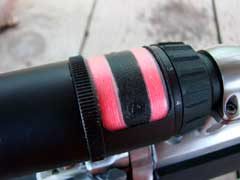
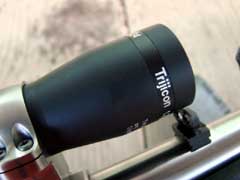
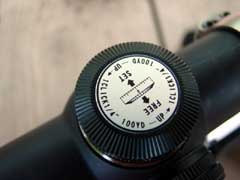
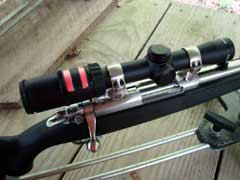
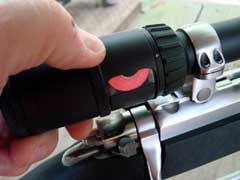
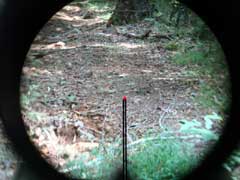
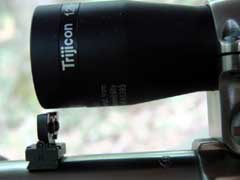
Trijicon AccuPoint scope.
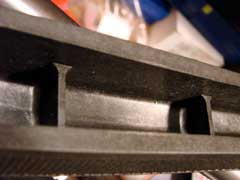
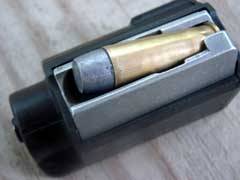
320-grain Cast Performance lead bullet fits
well into the magazine when crimped into the upper crimp
groove.
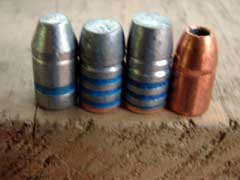
Left to right: Tennessee Valley 300-grain lead
flat point, 300-grain and 320-grain Cast Performance
lead gas-check, 250-grain Hornady JHP.
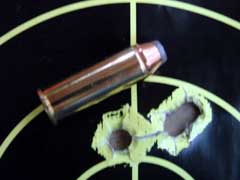
|
  
Got something to say about this article?
Want to agree (or disagree) with it? Click the following link to
go to the GUNBlast Feedback Page.
|
|
Click pictures for a larger version.
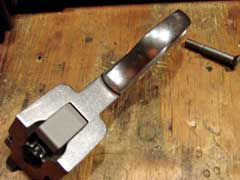
Trigger guard is made of stainless steel.
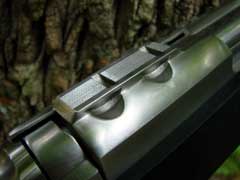
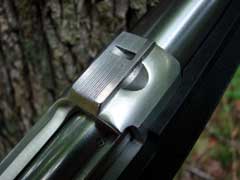
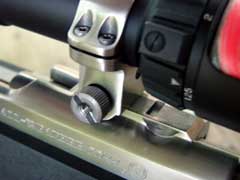
Scope mount bases are integral with the receiver.
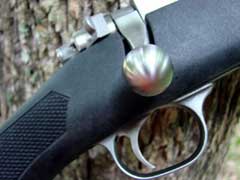
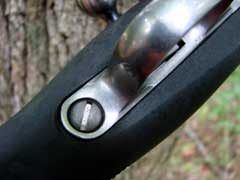
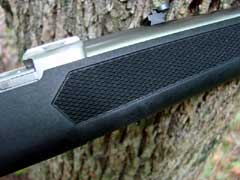
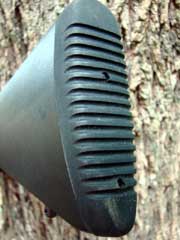
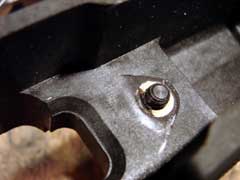
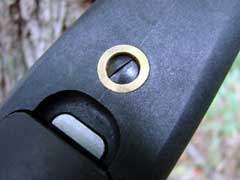
Bedding pillar in synthetic stock.
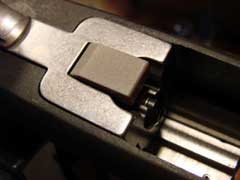
Magazine release.
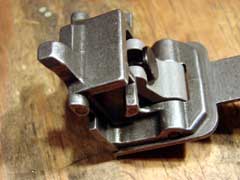
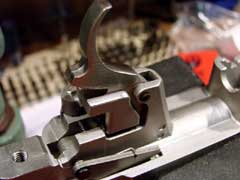
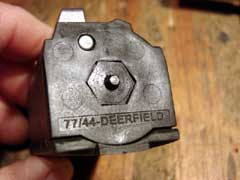
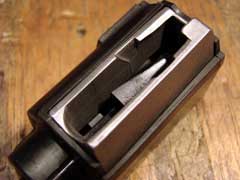
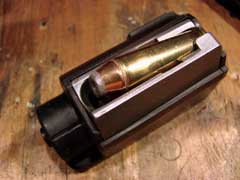
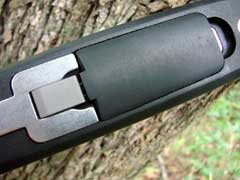
Four-shot rotary magazine fits flush with the
bottom of the rifle.
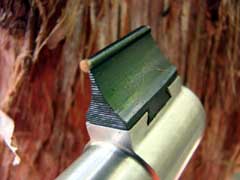
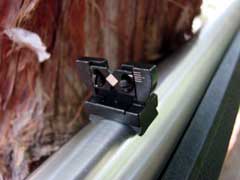
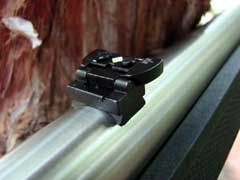
Open sights consist of bead front and folding
rear.
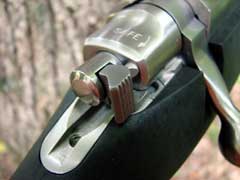
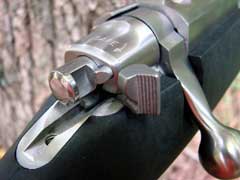
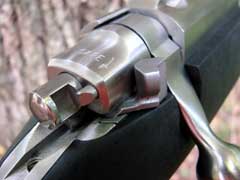
Three-position safety.
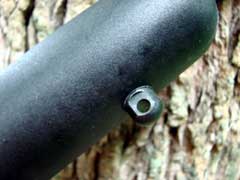
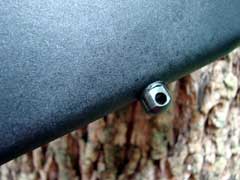
Sling attachment studs.
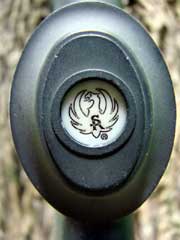
|
![]()